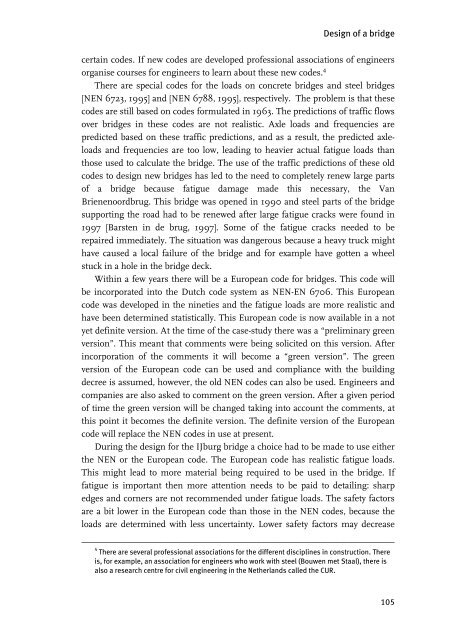Ethical issues in engineering design - 3TU.Centre for Ethics and ...
Ethical issues in engineering design - 3TU.Centre for Ethics and ...
Ethical issues in engineering design - 3TU.Centre for Ethics and ...
Create successful ePaper yourself
Turn your PDF publications into a flip-book with our unique Google optimized e-Paper software.
Design of a bridge<br />
certa<strong>in</strong> codes. If new codes are developed professional associations of eng<strong>in</strong>eers<br />
organise courses <strong>for</strong> eng<strong>in</strong>eers to learn about these new codes. 4<br />
There are special codes <strong>for</strong> the loads on concrete bridges <strong>and</strong> steel bridges<br />
[NEN 6723, 1995] <strong>and</strong> [NEN 6788, 1995], respectively. The problem is that these<br />
codes are still based on codes <strong>for</strong>mulated <strong>in</strong> 1963. The predictions of traffic flows<br />
over bridges <strong>in</strong> these codes are not realistic. Axle loads <strong>and</strong> frequencies are<br />
predicted based on these traffic predictions, <strong>and</strong> as a result, the predicted axleloads<br />
<strong>and</strong> frequencies are too low, lead<strong>in</strong>g to heavier actual fatigue loads than<br />
those used to calculate the bridge. The use of the traffic predictions of these old<br />
codes to <strong>design</strong> new bridges has led to the need to completely renew large parts<br />
of a bridge because fatigue damage made this necessary, the Van<br />
Brienenoordbrug. This bridge was opened <strong>in</strong> 1990 <strong>and</strong> steel parts of the bridge<br />
support<strong>in</strong>g the road had to be renewed after large fatigue cracks were found <strong>in</strong><br />
1997 [Barsten <strong>in</strong> de brug, 1997]. Some of the fatigue cracks needed to be<br />
repaired immediately. The situation was dangerous because a heavy truck might<br />
have caused a local failure of the bridge <strong>and</strong> <strong>for</strong> example have gotten a wheel<br />
stuck <strong>in</strong> a hole <strong>in</strong> the bridge deck.<br />
With<strong>in</strong> a few years there will be a European code <strong>for</strong> bridges. This code will<br />
be <strong>in</strong>corporated <strong>in</strong>to the Dutch code system as NEN-EN 6706. This European<br />
code was developed <strong>in</strong> the n<strong>in</strong>eties <strong>and</strong> the fatigue loads are more realistic <strong>and</strong><br />
have been determ<strong>in</strong>ed statistically. This European code is now available <strong>in</strong> a not<br />
yet def<strong>in</strong>ite version. At the time of the case-study there was a “prelim<strong>in</strong>ary green<br />
version”. This meant that comments were be<strong>in</strong>g solicited on this version. After<br />
<strong>in</strong>corporation of the comments it will become a “green version”. The green<br />
version of the European code can be used <strong>and</strong> compliance with the build<strong>in</strong>g<br />
decree is assumed, however, the old NEN codes can also be used. Eng<strong>in</strong>eers <strong>and</strong><br />
companies are also asked to comment on the green version. After a given period<br />
of time the green version will be changed tak<strong>in</strong>g <strong>in</strong>to account the comments, at<br />
this po<strong>in</strong>t it becomes the def<strong>in</strong>ite version. The def<strong>in</strong>ite version of the European<br />
code will replace the NEN codes <strong>in</strong> use at present.<br />
Dur<strong>in</strong>g the <strong>design</strong> <strong>for</strong> the IJburg bridge a choice had to be made to use either<br />
the NEN or the European code. The European code has realistic fatigue loads.<br />
This might lead to more material be<strong>in</strong>g required to be used <strong>in</strong> the bridge. If<br />
fatigue is important then more attention needs to be paid to detail<strong>in</strong>g: sharp<br />
edges <strong>and</strong> corners are not recommended under fatigue loads. The safety factors<br />
are a bit lower <strong>in</strong> the European code than those <strong>in</strong> the NEN codes, because the<br />
loads are determ<strong>in</strong>ed with less uncerta<strong>in</strong>ty. Lower safety factors may decrease<br />
——————————————————————————————————<br />
4 There are several professional associations <strong>for</strong> the different discipl<strong>in</strong>es <strong>in</strong> construction. There<br />
is, <strong>for</strong> example, an association <strong>for</strong> eng<strong>in</strong>eers who work with steel (Bouwen met Staal), there is<br />
also a research centre <strong>for</strong> civil eng<strong>in</strong>eer<strong>in</strong>g <strong>in</strong> the Netherl<strong>and</strong>s called the CUR.<br />
105



